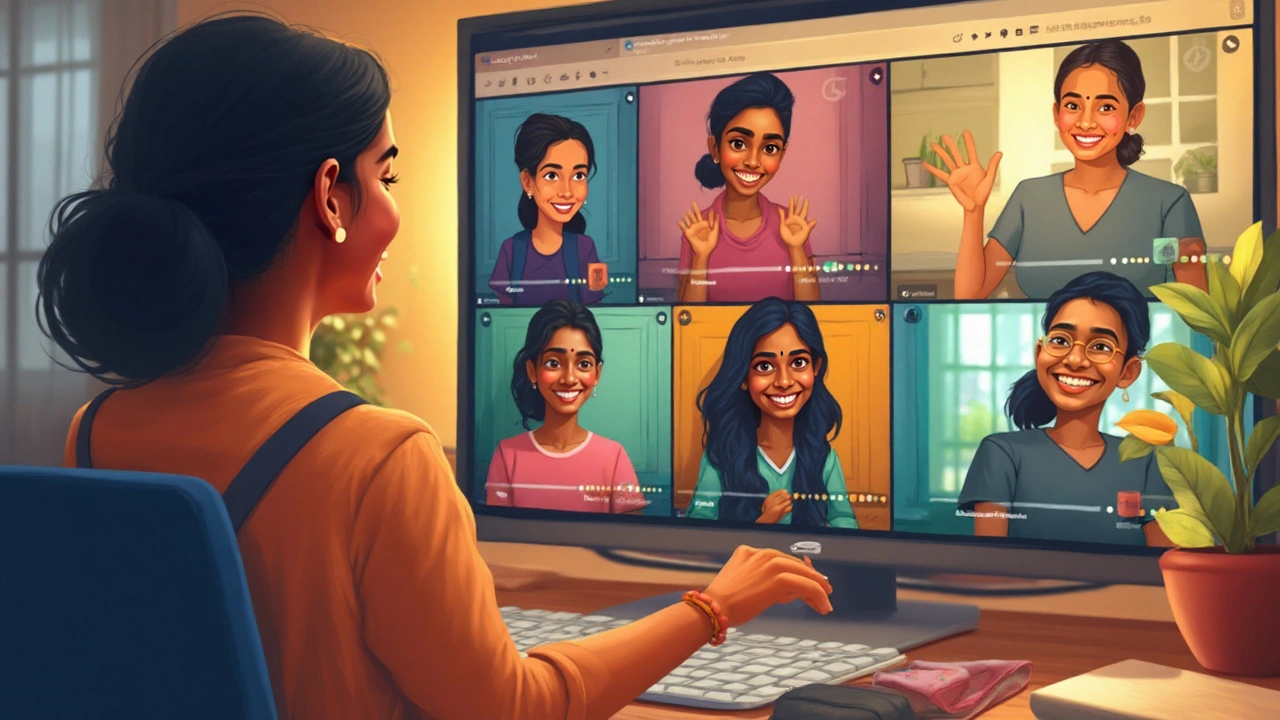Remember the time when sitting in a classroom, staring at a whiteboard, was the only way to learn? Fast forward to 2025, and you’re more likely to grab your phone or laptop, log in, and join a class in your pajamas. The numbers are wild—according to the World Economic Forum, over 300 million students participated in some form of online education last year. But is logging in from home really better than the good old chalk-and-talk? Or is it all just a techy bandwagon everyone’s supposed to hop on?
Why Online Classes Boomed: The Real Drivers
Ever felt like online classes went from optional to unavoidable overnight? There’s a reason behind this huge shift. Sure, the pandemic started the trend, forcing schools, colleges, and even dance studios online. But even after lockdowns ended, most people didn’t just dust off their backpacks and head back. They found something valuable in virtual learning. Convenience is a big deal. You grab breakfast at 8:55 am and join your 9 am class from your kitchen. It’s flexible—night owls can learn late, early birds can start at dawn.
There’s also the access factor. If you live in a small town or a remote area, you don’t have to move to a big city for better classes. Suddenly, classes from top universities or famous instructors open up to anyone with a decent internet connection. Data backs this up. In a 2024 survey by EdTech Magazine, 67% of students said online classes helped them balance family, jobs, and studies. This kind of flexibility just wasn’t possible a decade ago.
Let’s talk about the content, too. Online courses are quick to update—coding bootcamps, for example, often add new skills the moment a new technology becomes hot. You’re not stuck with dusty syllabuses. This “freshness” helps keep what you’re learning relevant in the fast-changing job world. Oh, and bonus: you don’t waste hours stuck in traffic or racing between classes on a giant campus. That alone is worth cheering for.
But here’s what doesn’t get talked about enough. The social aspect. Critics say online learning is lonely—no friendly chat over coffee or group projects at the library. But not all digital learning is faceless. Platforms like Discord, WhatsApp, and Slack have turned online student groups into actual communities where people help each other, share notes, and, yes, even crack jokes during boring lectures. My spouse Ananya teaches a writing course online, and her students set up their own book club—nobody told them to, they just did it. Community can happen on-screen, if you put effort into it.
The Upsides: Flexibility, Cost, and Learning at Your Pace
So what makes folks rave about online classes? The first thing—flexibility. Want to pause a video, rewind, or rewatch a tricky lesson? You can. Missed a class because life happened? No one shames you if you need to catch up at midnight. Many platforms let you download lectures, print handouts, and take quizzes as often as you want. For visual learners, having everything in one spot helps. For parents or working adults, this is freedom.
Money matters, too. Online programs, from IELTS prep courses to university degrees, are usually cheaper than traditional ones. You skip commute costs, save on pricey city rents, and often get access to free or low-cost resources—think downloadable textbooks or open-source tools. Even fancy degrees now have online versions that cut tuition in half.
Want some hard numbers? A 2025 survey by U.S. News & World Report found that tuition for online master’s programs averaged 32% less than on-campus degrees. This doesn’t include the side savings: no parking, no café lunches, no printed handouts. If you have a steady internet connection, you’re pretty much good to go.
Pace is another plus. People learn at different speeds. With online classes, no one stares if you take an extra minute on a lesson. If you ace something, you move on faster, instead of waiting for everyone else. Self-paced platforms like Coursera, Udemy, and BYJU’s let you set the tempo and tackle tough topics as many times as it takes. If you work full-time, you can still earn a certificate in your free hours. When was that an option before?
Don’t forget career boosts. Adding online certifications to your CV can help you move up or switch fields. According to LinkedIn’s 2024 Workforce Report, online learning was one of the top three strategies for landing a promotion. Companies are starting to respect these badges. If you’re in IT, digital marketing, or design, employers almost expect extra online certifications stacked on your resume now.
Online classes aren’t just for school kids or college students—professionals join, too. Popular platforms release bite-sized “micro-courses” on stuff like project management or data analysis that companies often encourage their staff to take. It’s common to see managers and interns, both, slogging through the same online modules. Skill-building never really stops, and online spaces let you keep up without taking time off work.
Feedback is quicker, too. Many teachers use digital quizzes, auto-graded assignments, and discussion forums to help you see where you stand. Some AI-driven platforms even give you hints if you miss a question. You’re no longer waiting a whole week to see if your essay bombed.
Here’s a quick snapshot of what students value in online learning:
| Top Benefit | Percent of Students (2024) |
|---|---|
| Schedule Flexibility | 68% |
| Lower Expenses | 54% |
| Access to Better Instructors | 33% |
| Self-Paced Learning | 42% |
So if you need school to fit your actual life, not the other way around, the upsides are hard to beat.

The Downsides: Distractions, Motivation, and Credibility Fears
Now, it’s not all sunshine. You’ve probably seen the memes about Netflix in one tab, class in the other. Staying motivated at home is tough. There’s laundry to fold, memes to scroll, snacks to eat. A Stanford study in early 2025 found nearly 41% of college students cited distractions at home as their number one struggle. Without teachers watching over your shoulder, it’s easy to drift off or skip a few modules. Discipline is a real beast.
Next up: Tech troubles. Internet down? Laptop crashes? Power cut mid-exam? Offline students never had to scream at routers or panic when screens froze. Then there’s the whole digital divide—fast WiFi isn’t everywhere, especially in rural towns or low-income neighborhoods. Even in 2025, this gap hasn’t fully closed. Some learning platforms run poorly on cheap phones or older computers, which puts extra burden on families already struggling.
Online courses often lack instant, face-to-face feedback, too. In a real class, you ask questions and get answers right away. In online classes, you type a question in a forum and sometimes wait hours or days to hear back. Sure, some professors schedule live video Q&As, but not all. Human interaction can feel thin, even with fancy discussion threads.
The “credibility” issue hasn’t died. Plenty of people, especially employers or older family members, worry that online degrees aren’t as legit as regular ones. To be fair, not all online programs are equal. Fly-by-night websites still offer “certificates” that aren’t worth the pixels they’re printed on. Choosing a recognized university or big-name teaching platform matters—otherwise, you risk wasting money, time, and effort for a certificate nobody respects. When you look up reports from the National Association of Colleges and Employers (NACE) in 2025, nearly half of hiring managers say they check the issuing institution before considering an applicant’s online course credits.
One problem students don’t notice at first is networking. In a campus, casual chats at the canteen or after class built contacts for jobs, internships, and life. Online, making meaningful connections is possible but takes more effort. Introverts may love the comfort zone, but extroverts sometimes feel stuck outside their tribe. Some online universities now run hybrid meet-ups—regional study groups, pop-up campus events, even Zoom parties—just to help solve this.
Assessment integrity is another problem. Cheating is easier behind a screen. Proctors try webcam monitoring and AI flagging, but those only go so far. It’s just harder to police, and everyone knows it, from students to institutions. This means online credentials sometimes get side-eyed, especially if there’s a whiff of “open book” leniency.
If you’re considering online classes, factor these challenges in. The best trick? Treat your online course like a real class. Set up a desk. Block “study time” in your calendar. Tell your family you’re not to be disturbed (unless it’s urgent, like someone set the kitchen on fire). Build the discipline you’d have in a physical classroom, and your chances of finishing skyrocket.
How to Make the Most of Online Learning: Real-World Tips
So, let’s say you want to give online classes a shot, or you’re already elbow-deep in them but barely holding on. How do you get the most out of them, instead of just surviving?
- Create a routine. Set a regular schedule, just like going to school. If 10 am works, show up at your desk every day at that time.
- Set up a ‘class zone’. Don’t study in bed, if you can avoid it. Carve out a space—a corner table, your kitchen, anywhere. Train your brain to associate that spot with learning.
- Join the forums. Even if you’re shy, drop questions and answers in class chat rooms. The more you engage, the more you root yourself in the experience—and it actually boosts your grades and recall.
- Use the tech. Take notes on a tablet, set reminders for coursework on your phone, or even use speech-to-text tools. Most platforms offer apps or browser plug-ins to make life easier—try them out.
- Keep distractions away. Tell family you’re “at class”. Plug in headphones, use website blockers, do what it takes to focus—Netflix and YouTube will wait.
- Don’t ghost your teachers. If you’re lost, email your professor or ask for help early. In the digital world, silence usually means “everything’s fine”—you miss out if you don’t speak up.
- Network actively. Volunteer for group projects, attend virtual meetups, connect on LinkedIn. These lightweight connections sometimes turn into job leads, references, or friendships—just like real school.
- Choose credible programs. Before enrolling, check accreditations, student reviews, and alumni outcomes. Big names (HarvardX, edX, Coursera, BYJU’s) usually come with built-in reputation—unknown names may not.
- Track your progress. Use spreadsheets, checklists, or built-in dashboards to stay on top of lessons, quizzes, and deadlines. Visual progress is super motivating.
Want proof that this stuff works? My friend Maya, a full-time mom of two, completed an entire coding bootcamp online last year. She blocked out two hours a night, put noise-canceling headphones on, and used a digital planner to manage assignments. By the end of the year, she was not only certified but landed a remote software job. If she can, anyone can.
Here are some standout platforms and what they’re known for in 2025:
| Platform | Best For |
|---|---|
| Coursera | University-level degrees, global variety |
| edX | STEM subjects, professional certificates |
| BYJU’s | K-12 students (India), test prep |
| Udemy | Bite-sized professional skills |
| Skillshare | Creative courses—design, video editing |
Don’t get stuck picking at random. Read up, ask alums, try free trials. The right fit makes all the difference.

